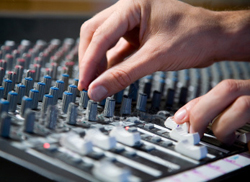
Most console EQ high frequency knobs are centered at about 12,000 hertz, usually abbreviated to 12 kHz (kilohertz ), and this is a measure of cycles per second.
In this case, 12 kHz equals 12,000 cycles per second. The more cycles, the higher in pitch the frequency.
For musicians, 12 kHz translates to the note F-sharp in the ninth octave on the piano. Or in simple layman’s terms, 12 kHz is pretty high.
What we’re trying to achieve with high frequencies are things like adding “crispness” to an instrument or taking the harsh “s” sounds out of a speaking or singing voice.
On most consoles, this knob controls what is called a shelf filter. Starting at the 12 kHz frequency, turning this control will effect all frequencies above 12 kHz.
In other words, by turning this knob to the right, frequencies above 12 kHz are boosted, normally with a maximum boost of 12 dB per octave.
One octave means affecting all frequencies up to 24 kHz. Turning it up too much can cause serious damage to the high-frequency section of loudspeakers, so caution is advised.
And, it follows that turning this knob to the left will cut these same frequencies. Just remember: using this control effects a broad frequency range so be aware of when cutting or boosting – do so only in small steps.
Moving To The Lows
Much the same is true of the low-frequency knob. It’s usually centered at about 80 Hz, and is used to enhance the bass level and signature of vocals and low-frequency instruments.
This is also a shelf type filter, like the high frequency control knob, and it controls about a two-octave area.
It boosts low frequencies at 80 Hz to 160 Hz, and cuts low frequencies at 80 Hz to 40 Hz. Again, every time the frequency is doubled or halved, it represents one octave of frequency range.
Excessive low frequency adjustment is far less likely to cause damage to loudspeakers. However; because low-frequency signals are made up of larger sound waves that tend to go “everywhere” and often cause feedback, we can use this knob to cut those frequencies back.
In general, with microphones on console channels being used for vocalists and pastors, you will want to turn down the low frequency on those channels to reduce the tendency for low-end rumble, and also to help speech intelligibility. (Eliminating the rumble will bring more clarity to the vocal signal.)
Another feature offered on some consoles is a low-cut filter on each channel. Pressing this button does just what the name implies – it cuts the low-frequency EQ.
A Combination
Now, what about the mid-range knob? Nothing that corresponds to the mid-range can be found on most home stereos – rather, mid-range on the home stereo is a combination of the bass and treble knobs.
However, on the console, the mid-range control doesn’t work exactly the same as the high- and low-frequency controls. When it is boosted or cut, it adjusts the frequencies on both sides of the center frequency.
